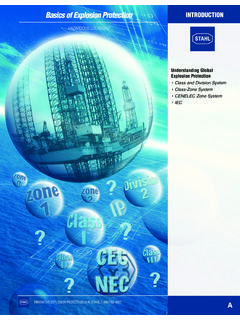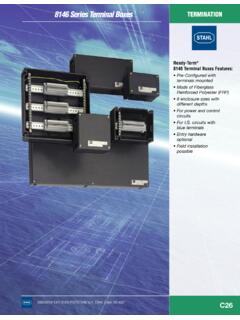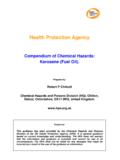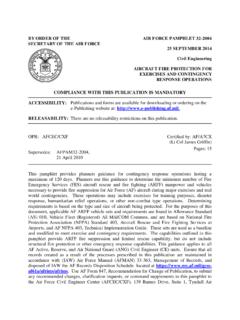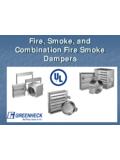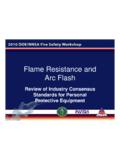Transcription of Basics of Explosion Protection INTRODUCTION - …
1 ABasics of Explosion ProtectionHAZARDOUS LOCATIONSINNOVATIVE Explosion Protection by R. STAHL 1-800-782-4357 Understanding Global Explosion Protection Class and Division System Class-Zone System CENELEC Zone System IECINTRODUCTIONA1 INTRODUCTIONB asics of Explosion ProtectionHAZARDOUS LOCATIONSINNOVATIVE Explosion Protection by R. STAHL 1-800-782-4357 HAZARDOUS LOCATIONSH azardous locations are defined as premises, buildings or parts thereof where fire or Explosion hazards may exist due to the presence of flammable gases or vapors, flammable liquids, combustible dusts, or easily ignitable fibers or flyings. Although, flammable gases, vapors and combustible dusts exist almost everywhere, fortunately, they are present only in minute quantities. Simply because flammable gasses or vapors, or combustible dusts are present, there is not necessarily a hazardous location.
2 The quantities or concentrations must be sufficient topresent a potential Explosion hazard. The electrical codes that deal with these types of hazardous locations areas do not deal with materials such as high explosives, such as dynamite, munitions, or fireworks. Other rules and regulations deal with areas involving these materials. Understanding Global Hazardous Location RequirementsThe evolution of hazardous location electrical codes and standards throughout the world has taken two distinct paths. In North America, a Class, Division System has been used for decades as the basis for area classification of hazardous (classified) locations. Because the hazards and methods of protecting electricalequipment against these hazards differ for different materials, hazardous locations are divided into three Classes, and two Divisions.
3 The Classes are based on the type of hazard and the explosive characteristics of the material with the Divisions being based on the occurrence or risk of fire or Explosion that the material presents. While the United States and Canada have some differences in acceptable wiring methods and product standards, their systems are very other parts of the world, areas containing potentially explosive atmospheres are dealt with using a Zone System . Zones are based predominantly on theInternational Electrotechnical Commission (IEC) and European Committee for Electrotechnical Standardization (CENELEC) standards. Whereas North America deals with multiple types of hazardous atmospheres, the North American Zone System presently addresses only flammable gases and vapors which is the equivalent to North America s Class I locations. The most significant difference in the Zone system is that the level of hazard probability is divided into three Zones as oppose to two Divisions.
4 While specific requirements differ, the Unites States and Canada have incorporated the Zone System for Class I, hazardous locations into their recent electrical code updates. Both systems provide effective solutions for electrical equipment used in hazardous locations and both have excellent safety LOCATION BASICSIn North America, hazardous locations are separated into three Classes or types based on the explosive characteristics of the materials. The Classes or type ofmaterial is further separated into Divisions or Zones based on the risk of fire or Explosion that the material poses. The Zone system has three levels of hazardversus the Division System s two levels. Basics of Explosion ProtectionHazardous MaterialsClass/Division SystemZone System Gasses or Vapors Class I, Division 1 Zone 0 Zone 1 Class I, Division 2 Zone 2 Combustible Dusts Class II, Division 1 Zone 20 Zone 21 Class II, Division 2 Zone 22 Fibers or FlyingsClass III, Division 1 Class III, Division 2No Equivalent The United States and Canada have adopted Zones for Gasses and Vapors Zones for Dust are not yet developed for North AmericaA2 INTRODUCTIONB asics of Explosion ProtectionHAZARDOUS LOCATIONSINNOVATIVE Explosion Protection by R.
5 STAHL 1-800-782-4357 Class I, LocationsClass I locations are those in which flammable "gases or vapors" are, or may be, present in the air in quantities sufficient to produce explosive or ignitible mixtures. The terms, "gases or vapors" differentiates between materials that are in a gaseous state under normal atmospheric conditions, such as hydrogen or methane, and a vapor that is flashed off from a liquid, under normal atmospheric conditions, such as gasoline. The subdivision of Class I, locations into Divisions or Zones is based on the probability that an explosive gas atmosphere may be present in a location. If the risk is extremely low, the location is considered non-hazardous. A good example of a low risk area is a single family home with natural gas or propane furnace for heating. The gas could, and does on extremely rare occasions, leak into the home, encounter an ignition source and an Explosion occurs, usually with devastating results.
6 However, since the risk is so low, because of the safety systems built into the gas supply and heating equipment, these areas are not hazardous classified locations .Recent editions of the NEC (National Electrical Code) and CEC (Canadian Electrical Code) have incorporated the international definitions for Zones for Class I,locations. The two codes continue to address the Division system although the methods are somewhat frequency of occurrence determines the level of hazard for a location. Simply stated, the longer the material is present, the greater the risk. The charts below compare the Division and Zone systems in terms of risk abnormal conditions of occurrence, or lower risk areas, in the Zone and Division system are basically identical. However, in areas where a hazard is expected to occur in normal operation, the Zone system deals with highest risk areas separately, and risk associated with the remaininglocation is considered lower.
7 The Division system tends to be less specific in its consideration of Division 1. The Division system treats all areaswhere a hazard is expected to occur in normal operation the following chart illustrates the differences between the various I, Division 1 RiskRiskDivision 1 Duration of time gas is present1 Hour per Year10 Hoursper YearZone 1 Zone 0 Zone 2 Division 2 Not ClassifiedNot ClassifiedDuration of time gas is present1 Hour per Year10 Hoursper Year1000 Hoursper YearFrequency of OccurrenceDivision SystemZone SystemContinuousZone 0 Intermittent PeriodicallyZone 1 Abnormal ConditionClass I, Division 2 Zone 2 Grade of ReleaseZoneFlammable Mixture PresentContinuous01000 hours per year or more (10%)Primary1 Between 10 and 1000 hours per year or more ( to 10%)Secondary2 Less than 10 hours per year ( to )Unclassified-Less than 1 hour per year (Less than )
8 This is a combination of Tables 2 and 3 from API RP505 The 1-hour per year used in API RP505 is considered to be high by some industry experts. Conservative estimates of this figure should be hours per of Explosion ProtectionHAZARDOUS LOCATIONSINNOVATIVE Explosion Protection by R. STAHL 1-800-782-4357 Class I locations are further divided into Groups based on the explosive properties of the materials present. North America has traditionally used four groups while theIEC and CENELEC use chart below compares the two GasClass/Division Gas GroupsZone Gas GroupsAcetyleneAHydrogenBEthyleneCII BPropaneDII A(The US has added a IIB + hydrogen group to address certain construction limitations.)Class II LocationsClass II locations are those which are hazardous due to the presence of combustible or electrically conductive dusts.
9 The dust must be present in sufficient quantitiesfor a fire or Explosion hazard to exist. The fact that there is some combustible dust present does not mean a Class II hazardous location exists. Class II substances are divided into three groups for similar reasons to those of Class I materials: equipment design and area classification. Class II groups are basedon different characteristics than those of Class I, given the requirements for an Explosion to occur and the Protection methods required for equipment. In Class II locations the ignition temperature, the electrical conductivity, and the thermal blanketing effect of the dust are critical when dealing with heat-producing equipment, such as lighting fixtures and motors. It is these factors which are the deciding factors in determining the Class II of MaterialExamplesEElectrically Conductive DustsPowdered Metals such as Aluminum or MagnesiumFCarbonaceous DustsCarbon Black, Coal Dust or Coke DustGAgricultural DustsGrain, Flour, Sugars, Spices and certain Polymers(The IEC has developed Zones for atmospheres containing combustible dusts, which again separates areas in to three Zones 20, 21 and 22.)
10 Zone 20, 21 and 22 LocationsThe IEC has recently introduced the three-Zone system for combustible dust locations. These have notbeen included in North American codes yet. The definitions are as follows:Zone20- an area in which a combustible dust, as a cloud, is present continuously or frequently during normal operations in sufficient quantities to produce an explosive an area in which a combustible dust, as a cloud, is likely to occur during normal operations in sufficient quantities to produce an explosive an area in which combustible dust clouds may occur infrequently and persist for only short periods of time or in which accumulations or layers may be present under abnormal III LocationsClass III locations are those which are hazardous due to the presence of easily ignitable fibers or flyings. However, the material is not suspended in the air in quantities sufficient to produce ignitable ignitable fibers and flyings present a serious fire risk, not normally an Explosion hazard.
